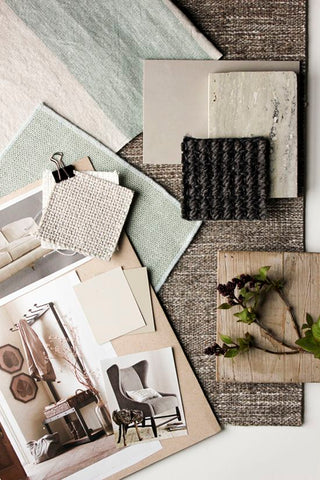Selecting Fabric
How to select the right fabric for your sofa or chair

A mood board for a room. Image source: kathykuohome.com
One of the most important decisions you can make when deciding to buy custom upholstery is what fabric to choose.
People are often attracted to a particular upholstery fabric because of its colour or pattern. It is important to remember the different characteristics of the fibres that comprise the various fabrics.
Our sales consultants will guide you in the right direction towards finding the right solutions to meet your particular requirements. While all fabrics showcased have been approved for use for upholstery, not all the fabrics are appropriate for your particular needs.
We are very well supported by the leading fabric houses such as Warwick, Zepel, Wortley, Mokum and many others. Here you can find the best fabrics from Australia and around the world. We also source quality leather from reputable suppliers like Leather Italia and N.S.W. Leather. You should be able to find something to suit your taste and budget.
Price does not always reflect quality
Our experience tells us that price point does not always directly reflect durability. Pricing often reflects only the cost to create the fabric (i.e. design, material used and country of origin etc.), but often has nothing to do with durability. In general, natural fibres are more costly to produce than synthetics; and woven patterns are more costly than plain weaves. The dyeing and looming process of a fabric also influence the price of a fabric.
Fabric ratings
One of the most important qualities of upholstery fabric is its wearability. Each fabric will have a use-rating, namely: domestic, heavy domestic, commercial, etc.
The Martindale Test is also widely used in Australia and Europe for testing upholstery fabrics. A high Martindale rating simply means that the fabric has undergone abrasion testing and has endured a certain amount of rubs to warrant its rating.
While only part of the story, the abrasion rating can be important when choosing a fabric for furniture which will endure a great deal of wear, such as a highly used family room.
Fabric weave
Another point to consider is fabric weave. As a guide, the tighter the weave the more durable the fabric; but remember, this is still only one piece of the puzzle along with the fibre composition. If you have dogs or cats, a loose weave or floating threads would not be a practical choice regardless of fibre content or use-rating.
Stain Resistance
If you're looking for fabric for dining chairs, stain resistance will be important. Some heavy duty fabrics may still be susceptible to staining, so fibre content may influence the choice. Synthetics fibres tend to be more difficult to dye, which also makes them less likely to hold stains. Fabric with some synthetic content would be preferable.
Most upholstery fabrics have a high synthetic fibre content, usually polyester. Polyester has the properties of great tensile strength and abrasion resistance. It is often used combined with natural fibres such as cotton or linen to provide stability and stain resistance, while still retaining the appearance and texture of the natural fibre.
A Note on Pilling
Pilling is the formation of tiny loose strands or balls of fibre on the surface of a piece of fabric. This can sometimes occur in upholstery fabric regardless of price tag, and has no bearing on fabric quality, functionality or durability at all.
Pilling is easily removed and isn't considered a fabric defect or fault, so it's not covered under warranty.
Where pilling comes from
Pilling is a normal occurrence very much like the shedding experienced in a new jumper or new carpet.
Loose fibres have a natural tendency to move to the surface of a piece of fabric, where they are subject to friction between furniture fabric and any other fabric that comes into contact with it such as clothing, cushions or throws.
Over time, this rubbing causes the various fibres to twist together into small balls on the surface of the material.
Pilling will reduce once the excess fibres are removed.

A battery powered Pill Shaver removes pilling on a sofa arm. Image credit: Ashley Poskin, Apartment Therapy
Removing pilling on upholstery
The most effective and quickest way to remove pilling is by the use of a battery-powered pill shaver. Pill shavers can be purchased from most haberdashery stores like Lincraft or Spotlight.
For more useful tips and a cleaning guide, visit Warwick.
Fabric Houses we recommend








